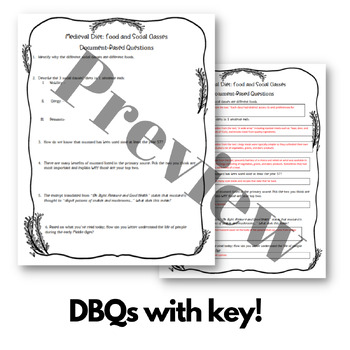Early Middle Ages Reading and DBQs - Food, Diet, & Social Classes (with recipe!)
- Zip
Also included in
- This bundle includes 70+ lessons on World History (detailed below). A large portion, especially the earlier lessons, are independent, original readings and questions. These work great for subs, days you need to catch up on other work etc, in a way that still gives rigor and value to your students. APrice $250.00Original Price $320.71Save $70.71
Description
This lesson is a wonderful way to get students engaged with Middle Ages content! It includes a reading and document-based questions (DBQs) that cover Middle Ages diets based on social classes. The reading includes 2 primary sources that take a mini dive into the history of mustard. There is also an optional recipe provided that you, as the teacher, can use to make a Medieval Vegetable Pottage to bring in for the students. It is a very simple slow cooker recipe. The lesson can be done without this activity.
The reading and questions are print and go so they would work well for a substitute plan if you are not doing the recipe. The reading and questions are on sperate pages so you can print a class set of the readings in order to save paper.
Please take a moment to leave a review, TPT will give you credits towards a future TPT purchase!
Follow HERE to get updated when sources are posted! =)
Included in this resource:
- 2-page reading
- 1 page of document based questions
- key for DBQs
- 2 slide PowerPoint for optional recipe
Thank you so much!






